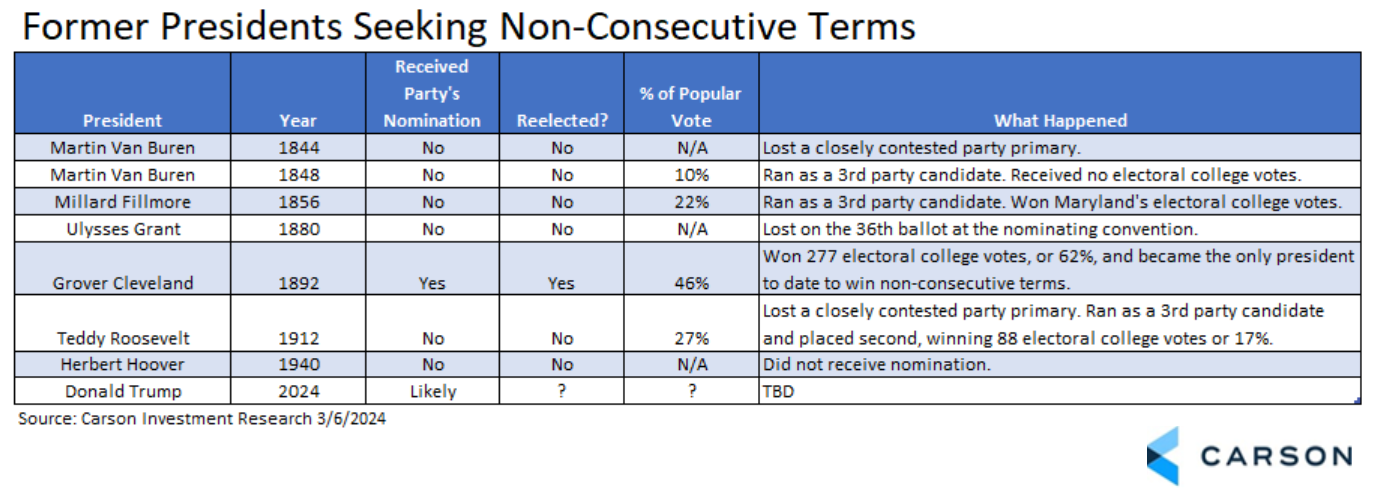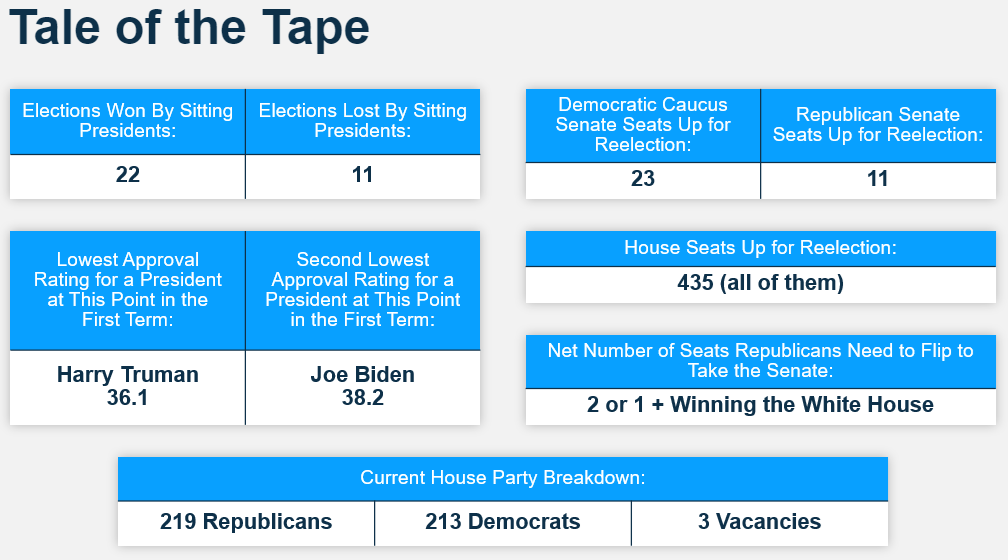The dust has settled on Super Tuesday, and it looks like the parties have chosen their champions for the November general election. Outside of American Samoa, Vermont, and Washington DC, President Joe Biden and former President Donald Trump have won every state for their respective parties. Barring something unusual, the 2024 election will be a rematch of 2020, in which Biden won 306 electoral college votes to Trump’s 232. But we all know the results were closer than they look and came down to just a few states.
Our democratic process is hard but also worth celebrating. As the saying goes, democracy is the worst political system in the world except for all the other ones. To celebrate the informal launch of the general election, the Carson Investment Research Team has started to roll out our election year content.
To get things going on Tuesday, our VP, Global Macro Strategist, Sonu Varghese tackled things we know about the path of policy and the economy even without knowing the election outcome in this insightful piece.
On Wednesday, our inimitable Chief Market Strategist, Ryan Detrick, rolled out 16 key charts and tables to be aware of ahead of the election.
My job is to tell you who is going to win. And the winner is …
Presidential Election 2024
I wish I knew who the winner would be, but as Ryan discussed in his piece, even if I did it would only give me a most a modest edge as an investor. Would it surprise you to know that during Biden’s first three years as president, the best performing S&P 500 sector has been energy while it was the worst performing sector during Trump’s first three years? Few would dispute that Trump’s policies were likely more energy friendly, but it just goes to show that economic forces often completely dominate the market impact of which party is in the White House.
As for who is going to win, right now it’s about as close to a coin toss as you can get. Yes, there have been small momentum shifts and there will be more over the next eight months, but polling error is larger than the likely margin of victory and polling error doesn’t include modeling error. That is, it assumes perfect polls, which anyone, from the typical voter, to professional pollsters, to any PhD in statistics, will tell you they are not.
Close presidential elections have become the norm, with six of the last seven having a margin of less than 5% in the popular vote. The last president to win the popular vote by more than a 10% margin was Ronald Reagan (+18.2%) in 1984. When it comes to the upcoming contest, we’re just going to have to all go and vote.
Democrats do have a slight edge in the popular vote, having won the popular vote in every presidential election but one over the last 30+ years. But, even if flawed, in our federalist system where each state is considered something of its own experiment in democracy, it’s the electoral college that counts. (Plus could you imagine trying to resolve a closely contested election where every vote in the country would need to be recounted?)

Stay on Top of Market Trends
The Carson Investment Research newsletter offers up-to-date market news, analysis and insights. Subscribe today!
"*" indicates required fields
What we do know about the election is the small handful of states that are likely to be the “tipping point state.” If you sorted the popular vote in each state (and a couple of congressional districts in states that aren’t “winner take all” in the electoral college) by popular vote, from the largest margin for one candidate to the largest margin for the other, the tipping point state is the first state that gave the winner their victory. Think of it as the state most in the middle. From 2000 to 2020 in order, the tipping point states have been Florida (famously) in 2000, Ohio, Colorado, Colorado, Pennsylvania, and Wisconsin. (In 2016 it was technically Wisconsin, but if you assign faithless electors to their state winner it was Pennsylvania.)
In 2024, the tipping point state is very likely to be one of just six states. Listed from most electoral college votes to least with the 2020 outcome in parentheses, they are Georgia (Biden +0.3%), Pennsylvania (Biden +1.2%), Michigan (Biden +2.8%), Arizona (Biden +0.4%), Wisconsin (Biden +0.8%), and Nevada (Biden +0.4%). Since Wisconsin was the tipping point state, that means that shifting the electorate 0.9% to the right would hypothetically be enough for Trump to win a second term. That kind of shift is small enough that it could just be the result of the news flow leading up to the election or even the weather.
Granted it’s eight months away, but if you’re tuning in on election night, the main reason to watch anything other than those state results is that if a candidate loses any other state they’re expected to win, it means they’re in trouble.
Trump Wants to Party Like It’s 1892
No matter what, this is going to be a historic election, in my opinion. Either candidate would be the oldest elected. But Trump is also trying to become only the second president to be elected for non-consecutive terms, joining Grover Cleveland, who was reelected in 1892 after losing to Benjamin Harrison as the incumbent in 1888. Incumbency is a strong advantage in presidential elections but by no means a lock. Historically, when an incumbent has won their party’s nomination, they have won 22 times and lost 11. There are also two presidents who sought their party’s nomination and didn’t get it. (For trivia buffs, an eligible incumbent president has not been their party’s candidate nine times, the two who did not win their party’s nomination and seven who chose not to run.)
What are Trump’s odds of winning non-consecutive terms? Based on history, it really depends on how you look at it. The only president who won their party’s nomination went on to win. That’s 100%. But six other former presidents either sought their party’s nomination, didn’t get it, and ran anyway or ran as a third-party candidate. Three of them actually received a meaningful share of the vote. Still, that reduces the historical frequency to one out of seven, or about 14%. Those numbers are really just for fun, so take your pick, but it does highlight how unusual this election is.
Given non-consecutive terms is so unusual, one question we get is whether Trump would still be the 45th president if he wins, or whether he would be the 47th. The presidential “count,” as usually presented, is the presidency, not the person. Cleveland is the 22nd and 24th president, so Trump would be the 45th and the 47th.
Don’t Forget Congress
As we all learned in high school civics, the federal government has three branches. The president executes the law, but Congress makes the law. In our view, the make-up of Congress can have as much of an impact on market outcomes as the party in the White House.
When it comes to the Senate, there’s a high probability it will flip to the Republicans, even if Biden wins the White House and almost certainly if Trump does. Only a third of the Senate is up for reelection every two years, since they have staggered six-year terms, and this year the map is especially bad for Democrats, who currently only hold a two-seat advantage. 23 Democrats (or independents who caucus with Democrats) are up for reelection and only 11 Republicans.
Add to that the retirement of Joe Manchin, the Democratic Senator from West Virginia. Manchin has been an anomaly—a Democratic senator from a solidly Republican state. That seat will almost certainly flip. Also, the Democratic two-seat advantage becomes just one if Trump wins the presidency, since the Vice President, currently Kamala Harris, breaks the tie. Basically, to hold the Senate, Democrats need to win the White House and run the table on the most contested Senate elections. It’s not an impossible path, but very unlikely.
When it comes to the House, you have to call it a toss-up for now. The current Republican advantage is small, at 219 to 213 with three vacancies, and every House seat is up for election every two years. Democrats look slightly more vulnerable, with more seats considered contested, but it may really come down to down-ballot effects from the presidential election. If Trump wins, the most likely case is a Republican Senate and House, but a Democratic House is possible. If Biden wins, the most likely case is a Republican Senate and a Democratic House, but a Republican House is possible.
Here’s a summary of the numbers we’re looking at going into the November elections:
Source: Carson Investment Research 3/6/2024
If you want to know more about what all that means from an economic and market perspective, see Sonu’s and Ryan’s blogs linked above. And we’ll continue to have more on the potential policy impact of the election and what it means for markets as election day approaches.
Our job, as always, will be to focus on market outcomes from a non-partisan perspective based on facts, not feeling. And fair warning, even if cliché we will tirelessly encourage all readers to vote, no matter which party you favor. As someone wise once said to me, it’s certainly important to vote because it might change the election, but it’s as important to vote because it changes you.
Ryan and Sonu also recently talked to PIMCO’s policy expert, Libby Cantrill, about the 2024 elections. Take a listen below
For more of Barry’s thoughts click here.
02146975-0324-A




